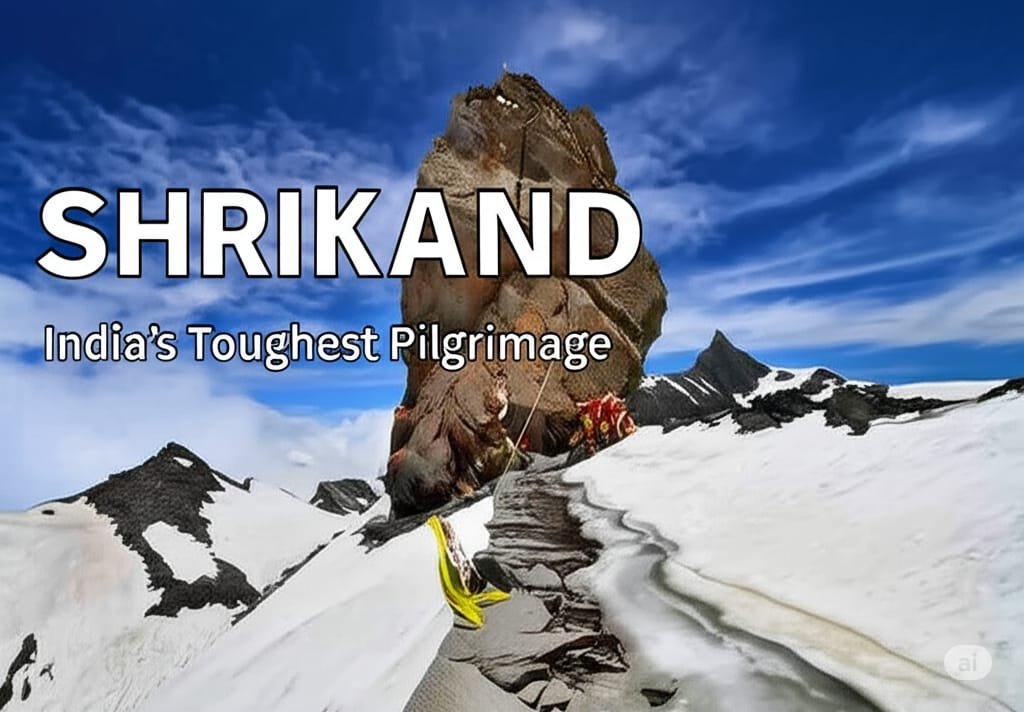The question that began this journey was simple: “Where does Mahadev live?” I had sought him in temples and cities, but I felt a pull towards his truest home—the high, desolate, and sacred peaks of the Himalayas. This led me to the Shrikhand Mahadev Yatra in Himachal Pradesh, a pilgrimage that is not just a trek, but a formidable test of physical endurance and spiritual surrender. This is the story of that journey, and of finding darshan not at a summit, but in the difficult decision to turn back.
A Crucial Warning Before You Read: The Shrikhand Mahadev Yatra is one of India’s most dangerous pilgrimages. It is extreme, and tragically, people lose their lives on this trail every year. In 2024 alone, two pilgrims passed away. This is not a casual trek. It should only be attempted during the official yatra window (usually in July), with a registered group, proper gear, and a deep respect for the mountain’s power.
For those prepared for the challenge, the journey starts from Jaon village in the Kullu district. The route progresses through Singhad, Thachdu, Kali Top (12,600 ft), Bheem Dwar, Parvati Bagh, and Nain Sarovar (14,500 ft) before the final, arduous climb to the Shrikhand Mahadev peak at approximately 18,700 ft.
The Journey to Jaon: The Last Village
My journey began from Delhi, a world away from the hardships that awaited. The road trip into Himachal’s interior led me to Jaon, a tiny hamlet of just 50 homes. This is the last bastion of civilization before you step into the raw wilderness. The air here is pure, the deodar forests are fragrant, and the only network that works is the one forged through human connection in the village’s basic homestays.
The Ascent: From Thachdu to the Divine View at Kali Top
The yatra officially begins with registration at Singhad. From there, the climb is relentless. The first major stop is Thachdu, a place where the exhaustion first truly hits you. The trail is often a near-vertical incline through dense forests and along rushing glacial streams.
The reward for this struggle came at Kali Top. I reached this ridge, at 12,600 ft, just before dawn. Watching the sun rise over the Himalayan panorama, illuminating a sea of clouds below, was a moment of pure, divine magic. It’s here you get your first distant glimpse of the Shrikhand Mahadev peak, a sight that fuels your spirit for the journey ahead.
Parvati Bagh and Nain Sarovar: A Glimpse of Heaven
Beyond Kali Top, the landscape transforms into something ethereal. You reach Bheem Dwar, a valley marked by a fluttering flag, and then ascend to Parvati Bagh. This high-altitude meadow, carpeted with mythical flowers, is believed to be the garden of Goddess Parvati herself.
Further up lies Nain Sarovar, a sacred glacial lake above 14,500 ft. Its icy, pristine water is said to be tears of devotion. The air here is thin, the silence profound. You are truly in the realm of the gods, a place where many pilgrims perform their ancient faith traditions, some even trekking barefoot in an ultimate act of surrender.
The Final Test: A Decision at the Glacier’s Edge
The final stretch from Nain Sarovar is the most perilous, involving a treacherous climb over boulders and a dangerous glacier crossing. As my team and I approached this section, we saw that the post-monsoon conditions had made the glacier unstable and extremely risky.
We were just 3 km from the summit, so close to the self-manifested Shivling where Lord Shiva is said to have meditated. But here, faith must be tempered with wisdom. I had to make one of the hardest decisions of my life: we had to turn back.
“Aadhe raaste se wapas lautna asaan nahi hota, lekin kabhi kabhi wapas aana hi sahi hota hai.” (Returning from halfway is not easy, but sometimes, returning is the right thing to do.)
My heart was heavy, but my spirit was clear. In that moment of surrender, we used a drone to get a visual darshan of the sacred peak. Seeing that divine pillar of rock on the screen, I realized that Mahadev isn’t just at the summit; He is in the journey, in the struggle, and most importantly, in the wisdom to respect nature’s limits and return safely.
An Uncompromising Guide to Safety on the Shrikhand Mahadev Yatra
- Trek ONLY During Official Dates: The administration sets up medical camps and rescue teams only during the official yatra period. Traveling outside this window is extremely dangerous.
- A Guide and Group are Mandatory: Never attempt this trek solo. Go with an experienced local guide and a group.
- Acclimatize Properly: Spend at least a day in a place like Jaon to let your body adjust to the altitude before starting the climb.
- Essential Gear is Non-Negotiable: This includes waterproof high-ankle trekking shoes, crampons for the glacier, a headlamp, multiple thermal layers, a waterproof jacket, and a personal first-aid kit with altitude sickness medication (consult a doctor).
- Stay Hydrated and Energized: Drink plenty of water mixed with hydration salts (ORS). Carry high-energy food like chocolate, nuts, and glucose.
A Final Reflection
Why do people risk their lives for darshan? I don’t think I found a complete answer, but I found my own. The Shrikhand Mahadev Yatra is a journey that pushes you to the brink. It strips away your ego and leaves you with a profound sense of humility. My pilgrimage was incomplete in distance, but spiritually, it was whole. I learned that true devotion isn’t about conquering a peak; it’s about understanding its power and knowing when to bow your head and walk away. The real darshan was the safe return, carrying the mountain’s silence and its lessons within me.

Leave a Reply